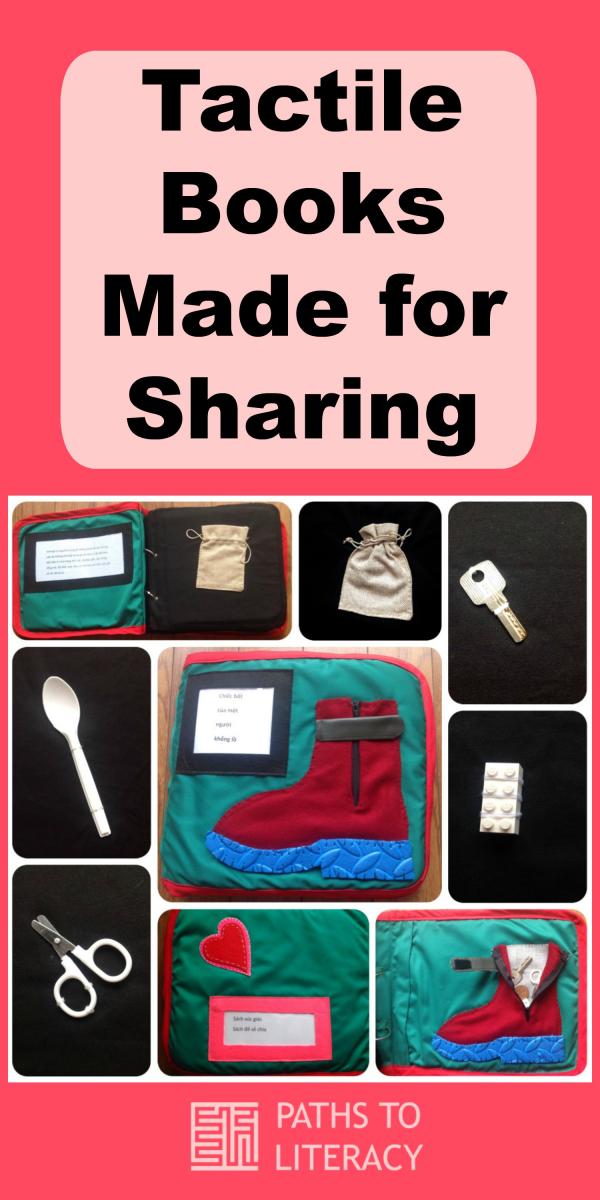Tactile Books Made for Sharing
also by Trịnh Thu Thanh and Hang Nguyen
We love braille and we want to have a library in Hanoi, Vietnam to lend tactile books to children with visual impairment. We hope our books will inspire a love of books and motivate children to want to learn to read braille.
Four Levels of Books
We are designing books at four levels starting with simple objects attached to the page and building up to tactile representations of difficult concepts, such as a deep lake.
Pre Level A: Pocket Books
"Experience books" are personal books usually made by parents or teachers for, or preferably with, a particular child about a shared activity the child took part in.
These books are meaningful because they are so personal and impossible to have in a library and so beyond the scope of our project.
However, our pocket (or bag) books are a bridge between experience books and our Level A object books. The adult and child are directed to make a book together by collecting objects from around the home according to the theme of the book such as "My Home" when the child puts an object from each room of the house into each pocket (pictured below).
On the front cover is a wooden door which can be opened and closed. The child is then instructed to go around the different rooms of their home and find something interesting to fit into the pockets. The pocket on the first page is for something from the living room, the 2nd is the kitchen then the bathroom, followed by the child's bedroom and finally someone else's bedroom.
On subsequent readings, it will be like their own expereince book. Before giving it back to the library, they remove their personal objects, ready for the next child to personalise.
Level A: Object Books
Real objects linked together by a theme or very simple story.
Real objects are attached to each page of the book and there is usually a very simple story linking the objects together with a satisfying ending. Examples that we have made so far are:
"Winter is here" and "Summer is here" both have clothes and objects appropriate to each season such as a hat, shoes, gloves. Some objects are attached with Velcro, so they can be removed and put on by the child, to aid recognition of the object and for fun.
Level B: Stories about familiar experiences or familiar objects, illustrated with objects and one or two simple tactile pictures
Objects and first tactile pictures are combined together to bring a simple story to life. The stories are based on familiar expereinces or familiar objects
"Little Shoes Go Out" has a pair of shoes that can be removed from the front cover and taken for a walk over various textured surfaces. There are a lot of sound words in the amusing story.
"The Giant’s Boot" has a tactile picture of a boot with real objects such as a key and spoon that are found in the boot.
Level C: Stories with a number of tactile pictures that further develop the child’s symbolic understanding, still based on familiar experiences
"Kana and Bull" is about a child called Kana over-coming her fear of a dog. We kept the original illustrations of the book and made a puppet of the bulldog as another way of helping to develop the child’s symbolic understanding, as we found the moving mouth made it easier to regnognise as a dog. The original pictures will help the story teller use the puppet. There are a number of tactile pictures of the same girl’s face with different facial expressions.
"Where is Momo going in such a hurry?" – has a baby doll and pictures which introduce tactile representation of going "up", "down", "along" and "over".
Level D: Stories which may be outside the child’s direct experience with some more abstract pictures
The stories may include experiences or objects outside the child’s direct experience or have concepts difficult to represent in a tactile picture. Therefore some pictures will be more abstract, i.e, be more difficult to interpret through touch and require a more developed symbolic understanding.
"Dad and I go fishing together" – This story was chosen as going fishing is a common hobby and ideal for children with visual impairment as it is not a visual activity. If the child hasn’t been fishing, they will need help to recognise the model of the fishing rod. A deep lake is a very abstract idea to represent with fabric. Beads and little leaves represent the lake bed. Each layer of fabric is like a pocket so the child can put their hand in between the layers and get the idea of depth.

Follow Tactile Books Made for Sharing on Instagram!
